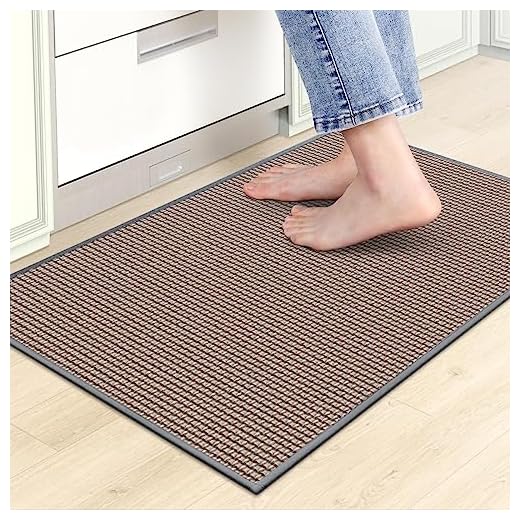Kitchen Rug Placement Ideas: How to Add Style and Comfort to Your Kitchen Floor
If you are looking for some kitchen rug placement ideas to spice up your cooking space, you are in the right place. A kitchen rug can add color, pattern, texture, and warmth to your kitchen floor, as well as cushion your feet and protect your flooring from spills and stains.
Nonetheless, choosing a suitable rug for your kitchen can prove to be a challenging task. It requires taking into account the dimensions, dimensions, materials, and design of the rug, as well as the layout of your kitchen and the traffic flow.
In this article, I will share some tips and inspiration on how to place rugs in your kitchen to create a cozy and inviting atmosphere.
Kitchen Rug Placement Ideas
Protect the Kitchen Triangle
The kitchen triangle is the area formed by the sink, the stove, and the refrigerator, which are the most frequently used spots in the kitchen. To ensure efficiency and safety, you should keep this area clear of any obstacles, including rugs. However, you can still place a small mat or runner in front of each appliance to catch any drips or crumbs, as long as they don’t interfere with opening doors or drawers. Alternatively, you can place a large rug that covers the entire triangle area, but make sure it is low-pile and non-slip to avoid tripping hazards.




![KMAT Kitchen Mat [2 PCS] Cushioned Anti-Fatigue Kitchen Rug, Waterproof Non-Slip Kitchen Mats and Rugs Heavy Duty PVC Ergonomic Comfort Foam Rug for Kitchen, Floor Home, Office, Sink, Laundry,Grey](https://m.media-amazon.com/images/I/51I8TYXeu-L._SS520_.jpg)

Define a Dining or Seating Area
If you have a dining table or a seating area in your kitchen, you can use a rug to define and separate it from the rest of the space. Placing a large kitchen rug underneath the kitchen table is a good idea to create a separation between that part of the room and the cooking and food prep area. Make sure to get a big kitchen rug that extends not only underneath the table but also the chairs when they’re pulled out to avoid having uneven leg chairs. You can also use a rug to anchor a seating area with a sofa or armchairs, creating a cozy spot for relaxing or chatting.
Cushion Your Feet
Standing for long periods of time on a hard kitchen floor can be tiring and uncomfortable for your feet, legs, and back. A rug can provide some cushioning and support for your feet, especially if you choose a soft and plush material like wool or cotton. You can place a rug in front of the sink or the stove, where you spend most of your time standing, or in any other spot where you need some extra comfort.
Add Color and Pattern
A rug can be a great way to add some color and pattern to your kitchen, especially if you have a neutral or monochrome palette. A rug can introduce some contrast, interest, and personality to your space, as well as complement or accentuate other elements like cabinets, countertops, or backsplash. You can choose a rug that matches or coordinates with your existing colors, or go for something bold and unexpected that pops out
Create a Focal Point
A rug can also serve as a focal point in your kitchen, drawing attention to a specific area or feature. You can select a rug that has an eye-catching design, such as a geometric print, a chevron pattern or a vintage-inspired motif. Alternatively, you can use a simple solid-colored rug that contrasts with the surrounding flooring.
Break Up a Large Space
If you have a large or open-plan kitchen, you may want to use rugs to break up the space into smaller zones or sections. Rugs can help create boundaries and transitions between different areas of the kitchen, such as the cooking zone, the dining zone and the living zone. You can use different rugs for each zone, or use similar rugs that create harmony and cohesion.




Hide Unsightly Flooring
Another reason to use rugs in your kitchen is to hide any unsightly flooring that you may have inherited from previous owners or renters. If you are not happy with your existing floor tiles or vinyls, but don’t have the budget or time to replace them, you can cover them up with rugs that suit your taste and style. Rugs can also hide any scratches, stains, or damage that may have occurred over time.
Add Warmth
Rugs can also add some warmth to your kitchen, both literally and figuratively. Rugs can insulate your floor from cold drafts and keep your feet warm during chilly days. They can also create a cozy and welcoming ambiance in your space, making it feel more like home. You can choose rugs that have warm colors, such as red, orange or yellow, or warm materials, such as wool, fur or faux fur.
Reduce Noise
Finally, rugs can help reduce noise in your kitchen, which can be a source of annoyance or distraction for you and your family. Rugs can absorb some of the sounds that come from appliances, utensils, dishes or footsteps, creating a quieter and more peaceful environment. This can be especially helpful if you have a busy or noisy household, or if your kitchen is adjacent to other rooms where you need some privacy or concentration.
Best Rug Under Dining Table
EARTHALL Cotton Buffalo Checkered Area Rug
It is made from cotton: This is a very durable and easy to clean rug material for high traffic places. The dining table is a high traffic area which makes this rug an ideal choice:
- Hand-woven
- Farmhouse checkered design
- The fabric
- Grace period
How to Place Rugs in Kitchen
Now that you have some ideas on why and where to use rugs in your kitchen, let’s see how to place them properly. Here are some general guidelines to follow:
- Measure your space and your rug before buying or placing it. You want to make sure that the rug fits well in your space and doesn’t look too big or too small.
- Leave some space between the rug and the walls or cabinets. You don’t want the rug to touch the walls or cabinets, as this can make the space look cramped and cluttered.
- Choose the right shape and orientation for your rug. Depending on the layout of your kitchen and the shape of your rug, you may want to place it horizontally, vertically or diagonally.
- Choose the right material and style for your rug. You want to select a rug that is durable, easy to clean and suitable for your kitchen’s style and theme.

![KMAT Kitchen Mat [2 PCS] Cushioned Anti-Fatigue Kitchen Rug, Waterproof Non-Slip Kitchen Mats and Rugs Heavy Duty PVC Ergonomic Comfort Foam Rug for Kitchen, Floor Home, Office, Sink, Laundry,Grey](https://m.media-amazon.com/images/I/51I8TYXeu-L._SS520_.jpg)

![Mattitude Kitchen Mat [2 PCS] Cushioned Anti-Fatigue Non-Skid Waterproof Rugs Ergonomic Comfort Standing Mat for Kitchen, Floor, Office, Sink, Laundry, Black and Gray](https://m.media-amazon.com/images/I/51ZDQDcq23L._SS520_.jpg)


FAQs
Where Should Kitchen Rugs Be Placed?
You should place kitchen rugs in the areas of the kitchen that experience the most foot traffic. In addition, you should also place a rug in the spots where there are more spills and stains.
Where Should Rugs Go in Kitchen?
Rugs can go anywhere in the kitchen, as long as they don’t interfere with the functionality and safety of the space. However, some common places where rugs go in the kitchen are:
- Underneath the kitchen table or island
- In front of the sink or stove
- Alongside the cabinets or counters
- In the center of the kitchen
- In front of the door or window
Final Thought
Rugs are not only functional, but also decorative accessories that can enhance your kitchen’s appearance and comfort. By following these kitchen rug placement ideas, you can find the perfect rug for your space and enjoy its benefits. Whether you want to protect your floor, define your zones, cushion your feet, add color and pattern, create a focal point, break up a large space, hide unsightly flooring, add warmth or reduce noise, there is a rug for you.




![KMAT Kitchen Rugs and Mats [2 PCS] Super Absorbent Microfiber Kitchen Mat Non Slip Machine Washable Runner Carpets (Chocolate-17.3" x28+17.3"x47")](https://m.media-amazon.com/images/I/51QuaklffNS._SS520_.jpg)
![Mattitude Kitchen Mat [2 PCS] Cushioned Anti-Fatigue Non-Skid Waterproof Rugs Ergonomic Comfort Standing Mat for Kitchen, Floor, Office, Sink, Laundry, Black and Gray](https://m.media-amazon.com/images/I/51ZDQDcq23L._SS520_.jpg)











